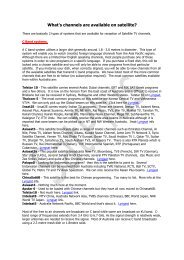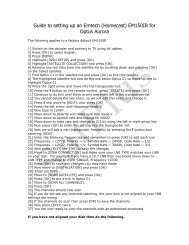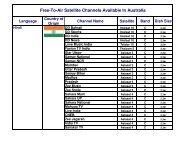pdf guide - SatPlus
pdf guide - SatPlus
pdf guide - SatPlus
Create successful ePaper yourself
Turn your PDF publications into a flip-book with our unique Google optimized e-Paper software.
Guide to Installing a KU Horizon to Horizon motor - Strong 4653X<br />
screenshots<br />
Before you start, you should be aware of the satellites that are available using a KU band dish and<br />
motor. When we talk of KU band dishes, we are referring to dishes generally between 0.65m and<br />
1.2m in diameter. In most areas of Australia, you will be able to receive NSS6, Asiasat4, Optus D2,<br />
Optus C1, Optus D1, Intelsat8 and Intelsat2 and in Eastern Australia, INTELSAT701.<br />
Most of these satellites carry either pay TV or free to air, foreign language programs. For a list of the<br />
most common programs on these satellites, click here .<br />
First, choose a location on your property that will allow the dish to 'see' the satellites from West to<br />
East keeping in mind that as the dish rotates, the elevation angle decreases so make sure there are<br />
no trees or buildings in the way.<br />
Install your pole mount using a spirit level to ensure that the pole is vertically plumb level. This is<br />
important.<br />
Now attach the satellite dish to the motor and ensure that the dish is aligned to the centre line of the<br />
motor pole. Tighten up the dish U bolts firmly. Lift the entire assembly onto your mast and tighten<br />
the motor U bolts up (not too tight as you'll need to adjust this)<br />
Set the elevation on the motor bracket to match your latitude. This conversion has already been<br />
calculated by the motor manufacturer so setting the elevation is easy. You can get your latitude from<br />
this website. The picture above shows the setting for Brisbane but this setting will vary depending on<br />
your geographic location.<br />
You'll now need to set the declination angle. This angle is set by adjusting the dish elevation<br />
assembly. Using the chart below, find your declination angle and deduct this from 40. The answer<br />
will equal your declination angle. See the picture on the right above.
Latitude Declination<br />
Angle<br />
Latitude Declination<br />
Angle<br />
Latitude<br />
Declination<br />
Angle<br />
Latitude<br />
Declination<br />
Angle<br />
1 0.18 24 4.07 46 6.92 69 8.47<br />
2 0.36 25 4.23 47 7.01 70 8.51<br />
3 0.53 26 4.38 48 7.11 71 8.54<br />
4 0.71 27 4.53 49 7.21 72 8.56<br />
5 0.89 28 4.67 50 7.30 73 8.59<br />
6 1.06 29 4.82 51 7.38 74 8.61<br />
7 1.24 30 4.96 52 7.47 75 8.63<br />
8 1.41 31 5.10 53 7.55 76 8.64<br />
9 1.59 32 5.24 54 7.63 77 8.66<br />
10 1.76 33 5.38 55 7.71 78 8.67<br />
11 1.94 34 5.51 56 7.78 79 8.67<br />
12 2.11 35 5.64 57 7.85 80 8.68<br />
13 2.28 36 5.77 58 7.92 81 8.68<br />
14 2.45 37 5.90 59 7.99 82 8.68<br />
15 2.62 38 6.02 60 8.05 83 8.68<br />
16 2.79 39 6.14 61 8.11 84 8.67<br />
17 2.95 40 6.26 62 8.16 85 8.66<br />
18 3.12 41 6.38 63 8.22 86 8.65<br />
19 3.28 42 6.49 64 8.27 87 8.64<br />
20 3.44 43 6.60 65 8.31 88 8.62<br />
21 3.60 44 6.71 66 8.36 89 8.60<br />
22 3.76 45 6.81 67 8.40 90 8.58<br />
23 3.92 68 8.44<br />
Switch off your decoder and connect a coaxial cable from the 'DISH IN' or 'LNB IN' on the back of the<br />
decoder and run this up to the motor marked 'REC'. Now connect a short cable from 'LNB' on the<br />
motor to the LNB on the end of your dish. Make sure the cables will not foul on the dish as it rotates.
Switch on your decoder. This will send the power up the coaxial cable to the motor and LNB. Click<br />
here to find your latitude and longitude. Now that you have your lat/long, visit this link and enter<br />
156° into the satellite orbit field, enter your latitude (remember to enter it as a minus figure) and<br />
longitude into the site lat and long fields and click to calculate results. The picture should look like<br />
the one below except your lat and long may be different:<br />
Note the dish azimuth relative to true north (X°) field. Pressing the manual East button on the motor,<br />
rotate the dish until the directional degree indicator on the top of the motor is pointing to X°. Go<br />
into the decoder's motorised settings screen (assuming you've already set up the LNB settings) and<br />
enter the information from the screen below:<br />
Moving the entire assembly, find signal on Optus C1. You may have to vary your elevation and/or<br />
declination angle slightly to fine tune. Once maximum signal is acquired, tighten the whole<br />
assembly. You should now be able to track most satellites using the motorized option within the<br />
receiver menu storing each position as you go. Be sure to use frequencies that are broadcast into<br />
Australia on each satellite. See www.lyngsat.com for more info on this.







